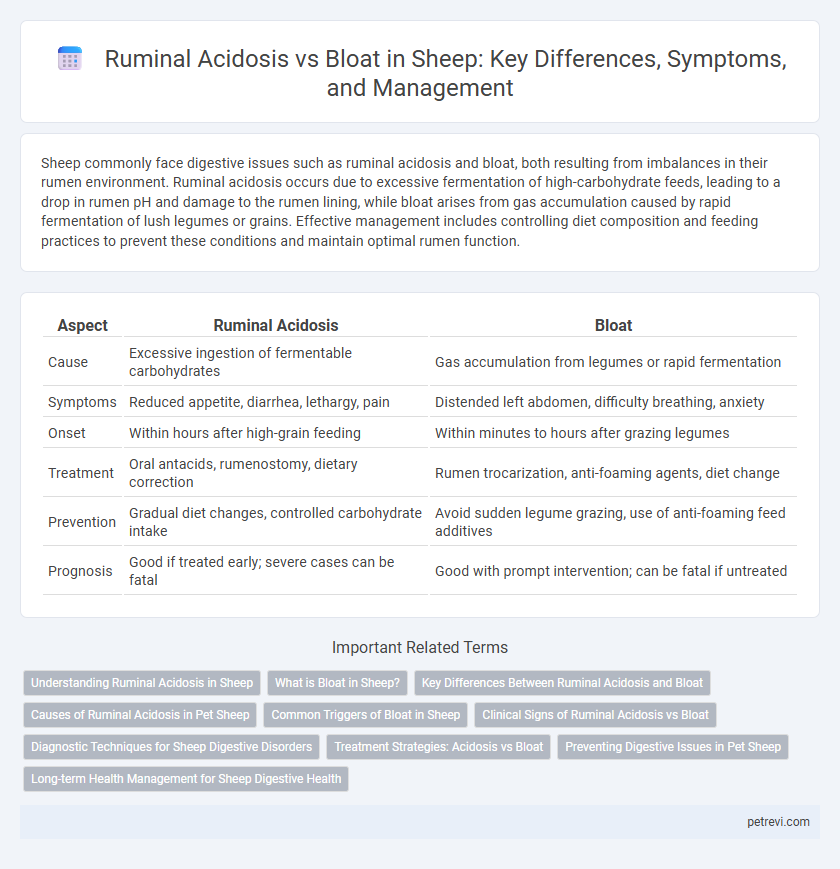Sheep commonly face digestive issues such as ruminal acidosis and bloat, both resulting from imbalances in their rumen environment. Ruminal acidosis occurs due to excessive fermentation of high-carbohydrate feeds, leading to a drop in rumen pH and damage to the rumen lining, while bloat arises from gas accumulation caused by rapid fermentation of lush legumes or grains. Effective management includes controlling diet composition and feeding practices to prevent these conditions and maintain optimal rumen function.
Table of Comparison
| Aspect | Ruminal Acidosis | Bloat |
|---|---|---|
| Cause | Excessive ingestion of fermentable carbohydrates | Gas accumulation from legumes or rapid fermentation |
| Symptoms | Reduced appetite, diarrhea, lethargy, pain | Distended left abdomen, difficulty breathing, anxiety |
| Onset | Within hours after high-grain feeding | Within minutes to hours after grazing legumes |
| Treatment | Oral antacids, rumenostomy, dietary correction | Rumen trocarization, anti-foaming agents, diet change |
| Prevention | Gradual diet changes, controlled carbohydrate intake | Avoid sudden legume grazing, use of anti-foaming feed additives |
| Prognosis | Good if treated early; severe cases can be fatal | Good with prompt intervention; can be fatal if untreated |
Understanding Ruminal Acidosis in Sheep
Ruminal acidosis in sheep occurs when rapid fermentation of high-carbohydrate feeds leads to excessive production of lactic acid, lowering rumen pH and disrupting microbial balance. This condition causes symptoms such as decreased feed intake, lethargy, and severe cases may result in rumen wall damage or systemic illness. Effective prevention includes gradual dietary changes, adequate fiber intake, and monitoring for early signs to maintain rumen health and prevent complications.
What is Bloat in Sheep?
Bloat in sheep is a severe digestive condition characterized by the accumulation of gas in the rumen, causing distention and discomfort. It often results from rapid ingestion of lush, legume-rich pastures, which produce stable foam that traps gas and prevents normal eructation. If untreated, bloat can lead to respiratory distress, reduced feed intake, and potentially fatal outcomes due to pressure on the diaphragm and other organs.
Key Differences Between Ruminal Acidosis and Bloat
Ruminal acidosis in sheep results from excessive fermentation of carbohydrates, leading to a drop in rumen pH and acid buildup, whereas bloat occurs due to gas accumulation in the rumen that cannot be expelled. Symptoms of ruminal acidosis include lethargy, diarrhea, and reduced feed intake, while bloat presents with abdominal distension and respiratory distress. Treatment strategies differ; ruminal acidosis requires pH neutralization and dietary adjustments, whereas bloat often demands immediate decompression or anti-foaming agents to release trapped gas.
Causes of Ruminal Acidosis in Pet Sheep
Ruminal acidosis in pet sheep primarily arises from the rapid fermentation of high-starch or high-sugar feeds, such as grains and concentrated pellets, leading to excessive lactic acid production in the rumen. This acid buildup disrupts the ruminal pH balance, damaging the microbial population essential for digestion. Unlike bloat, which is caused by gas accumulation from frothy or free gas obstruction, ruminal acidosis results from dietary imbalances and sudden feed changes that overwhelm the rumen's fermentation capacity.
Common Triggers of Bloat in Sheep
Common triggers of bloat in sheep include excessive consumption of lush legumes such as clover and alfalfa, which produce rapid fermentation and gas buildup in the rumen. Grazing on high-grain diets or sudden dietary changes can also disrupt rumen function, leading to frothy bloat or free-gas bloat. Environmental factors like stress and restricted water intake further exacerbate the risk of bloat in sheep.
Clinical Signs of Ruminal Acidosis vs Bloat
Ruminal acidosis in sheep typically presents with signs such as decreased feed intake, lethargy, diarrhea, and a sour smell to the breath due to lactic acid accumulation. Bloat is characterized by visibly distended left paralumbar fossa, respiratory distress, and discomfort caused by excessive gas accumulation in the rumen. Both conditions require prompt diagnosis, but the bloating in bloat contrasts with the more systemic acidosis symptoms seen in ruminal acidosis.
Diagnostic Techniques for Sheep Digestive Disorders
Ruminal acidosis in sheep is identified through rumen fluid analysis revealing low pH below 5.5, while bloat diagnosis involves physical examination showing abdominal distension and auscultation for fluid or gas sounds. Ultrasonography and rumen motility assessment enhance diagnostic accuracy by detecting gas accumulation or impaired contraction patterns. Laboratory tests, including blood gas analysis and electrolyte measurement, support differentiation between these digestive disorders in sheep.
Treatment Strategies: Acidosis vs Bloat
Treatment strategies for ruminal acidosis in sheep primarily involve administering oral buffers like magnesium oxide or sodium bicarbonate to neutralize rumen pH and providing activated charcoal or antacids to absorb toxins. In contrast, bloat requires immediate intervention with anti-foaming agents such as poloxalene or vegetable oils to break down frothy gas and, in severe cases, emergency rumenotomy to release trapped gas. Both conditions necessitate dietary adjustments and hydration support to restore optimal ruminal function and prevent recurrence.
Preventing Digestive Issues in Pet Sheep
Maintaining a balanced diet rich in fiber and low in rapidly fermentable carbohydrates is essential for preventing ruminal acidosis and bloat in pet sheep. Providing consistent access to clean water and encouraging regular exercise supports optimal rumen function and reduces digestive disturbances. Routine monitoring for early signs like bloating, lethargy, or decreased feed intake enables timely intervention and improved sheep health.
Long-term Health Management for Sheep Digestive Health
Effective long-term management of sheep digestive health requires distinguishing between ruminal acidosis and bloat, as each condition demands specific interventions. Ruminal acidosis results from excessive fermentable carbohydrates causing a drop in rumen pH, while bloat arises from gas accumulation due to frothy or free-gas retention, both impacting nutrient absorption and overall productivity. Implementing dietary strategies, monitoring pasture composition, and providing appropriate mineral supplements are critical measures to prevent recurring episodes and promote sustained digestive stability in flocks.
Ruminal Acidosis vs Bloat for Sheep Digestive Issues Infographic

 petrevi.com
petrevi.com